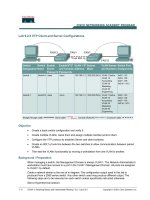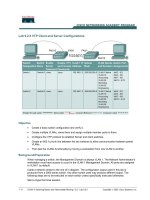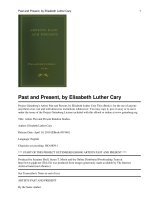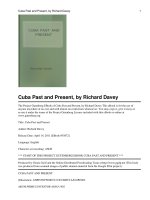3 2 5 houses past and present (social studies)
Bạn đang xem bản rút gọn của tài liệu. Xem và tải ngay bản đầy đủ của tài liệu tại đây (4.64 MB, 14 trang )
Suggested levels for Guided Reading, DRA,™
Lexile,® and Reading Recovery™ are provided
in the Pearson Scott Foresman Leveling Guide.
Houses
Past and Present
by Donna Watson
Genre
Nonfiction
Expository
nonfiction
Fiction
Comprehension
Skills
Skill and
and Strategy
Strategy
• First
DrawItem
Conclusions
• Fact
Second
andItem
Opinion
• Ask Questions
Text Features
•
•
•
•
Diagram
Item
1
Captions
Item
2
Labels
Item
3
Glossary
Item
4
Scott Foresman Reading Street 3.2.5
ISBN 0-328-13351-5
ì<(sk$m)=bd fbc< +^-Ä-U-Ä-U
Reader Response
1. Which improvements in home building do
you think were the most important?
2. You have traveled back to a colonial farm
in 1700. What two questions would you
ask the farmer about his home?
Houses
3. You are an English colonist. Using at least
Past
Present
three words from
theand
glossary,
write a
Donna Watson
letter home tobyEngland
describing the
house you have built. Set up your letter
like the one below.
Dear
,
,
4. How does the image on page 11 help you
understand how mortise and tenon work?
Editorial Offices: Glenview, Illinois • Parsippany, New Jersey • New York, New York
Sales Offices: Needham, Massachusetts • Duluth, Georgia • Glenview, Illinois
Coppell, Texas • Ontario, California • Mesa, Arizona
Every effort has been made to secure permission and provide appropriate credit for
photographic material. The publisher deeply regrets any omission and pledges to
correct errors called to its attention in subsequent editions.
Unless otherwise acknowledged, all photographs are the property of Scott Foresman,
a division of Pearson Education.
Photo locators denoted as follows: Top (T), Center (C), Bottom (B), Left (L), Right (R),
Background (Bkgd)
Opener: Christopher Rennie/Robert Harding Picture Library Ltd.; 1 Library of
Congress; 3 (T) Library of Congress, (TC) ©DK Images; 4 David Lyons/©DK Images;
5 (Bkgd) Library of Congress, (C) Bettmann/Corbis; 6 (BL, BR) ©DK Images;
7 ©DK Images; 8 ©DK Images; 9 Corbis; 10 Library of Congress; 11 (BC) ©DK Images;
12 (C) ©DK Images, (BL) Getty Images; 13 ©DK Images; 14 Christopher Rennie/Robert
Harding Picture Library Ltd.; 15 Cary Wolinski/Aurora Photos; 17 (T, B) ©DK Images;
18 Getty Images; 19 Getty Images; 20 (TL) Library of Congress, (CL) Kevin R. Morris/
Corbis, (BC) ©DK Images; 21 Getty Images; 22 ©DK Images; 23 Christopher Rennie/
Robert Harding Picture Library Ltd.
ISBN: 0-328-13351-5
Copyright © Pearson Education, Inc.
Where do you go when there is a storm? If
you’re wise, you stay inside your home, school,
or another building. You don’t want to be stuck
outside! Buildings and other shelters protect us
from the weather. Everyone needs shelter.
Have you ever thought about how shelter
has changed since the early years of the United
States? Three hundred years ago, America was
not a separate country. Instead, it was several
settlements of people ruled by Great Britain.
These settlements were called colonies. Because
settlers lived in colonies, this period of time
is known as the colonial era. The colonial era
lasted until 1776. The people who came to settle
here during that time were called colonists.
All Rights Reserved. Printed in the United States of America. This publication is
protected by Copyright, and permission should be obtained from the publisher
prior to any prohibited reproduction, storage in a retrieval system, or transmission
in any form by any means, electronic, mechanical, photocopying, recording, or
likewise. For information regarding permission(s), write to: Permissions Department,
Scott Foresman, 1900 East Lake Avenue, Glenview, Illinois 60025.
2 3 4 5 6 7 8 9 10 V0G1 14 13 12 11 10 09 08 07 06 05
3
When the colonists arrived, there were no
houses, hotels, or motels. There were no supply
stores. So how did the colonists find shelter?
They built their houses by using supplies they
had brought and materials from the surrounding
land. There were many challenges to settling
the new land. One of the biggest was making
shelters before winter came.
Since the colonists arrived by ship, the ship
was their home while the first houses were
being built. A common house was built first to
store the building tools and other supplies. The
single men of the group stayed on shore in the
common house to ease crowding on the ship.
As the houses were built, families left the ship
and moved into them. Smaller families shared
houses until enough houses were built for each
family to have its own.
4
Colonists came to the New World
on sailing ships like this one.
5
The colonists chopped down trees from
nearby forests to build their homes. Although
they used clay to fill in the spaces between
the logs, their houses were often very drafty.
This was because the colonists had a difficult
time finding logs of equal size and fitting them
together in exactly the right way.
The colonists built homes similar to the
homes they were used to. Many of these early
homes had thatched roofs, which were common
in England. Thatch is straw or leaves that have
been gathered and bundled together to be used
as a roof or covering.
Early colonial houses were small, wooden structures
with thatched roofs and wooden chimneys.
6
Wattle and daub between the braces formed
the walls of the first settlers’ homes.
As colonial life in America progressed, people
learned to build better homes. Supports called
cross braces made the houses stronger. Less
wind, dust, rain, and snow entered the houses
because the spaces between the braces were now
filled in with a combination of wattle and daub.
Wattle is the name given to twigs and sticks that
are woven together. Daub is a mixture of clay,
straw, and water. The wattle and daub were a big
improvement over the clay used earlier.
The first colonial chimneys were usually
made of wood and lined with clay. As soon as
the colonists were able to make chimneys out
of bricks or stones, they switched to using those
building materials. Chimneys made out of bricks
and stones are far safer than wooden ones, which
could catch fire easily.
7
The Swedish and Finnish colonists of
Delaware built the first true log cabins in
America. By this time the colonists had learned
that carving the logs at both ends allowed them
to fit together much better. Moss, leaves, and
mud were stuffed between the logs to keep out
the cold and wind.
Window openings were covered with oiled
paper. This paper let in some light. Often, a
blanket would be hung in the doorway because
doors were difficult to make at that time.
Log cabin roofs usually were covered with
bark or large wooden shingles called shakes.
Roofs were sloped so that snow would slide
down and off. Chimneys and fireplaces were
often made of rocks and stones. The fireplaces
were used for heating the home and cooking.
8
The beams on the ceiling of this home fit together.
Settlers fastened the logs together with
wooden pegs that they made by hand. Before
blacksmiths were common in the colonies,
nails had to be shipped from Europe. Later,
blacksmiths shaped nails and hinges so that
doors and cabinets could be hung.
When people couldn’t pay for a blacksmith,
they were able to hang doors by attaching
them to walls with leather straps. In this case,
latchstrings were used to open the doors.
9
This area was used for cooking and eating.
Most early colonial homes were simple,
rectangular-shaped buildings that measured
about sixteen feet long and fourteen feet wide.
Many had a loft in the top with a small ladder
that was attached to the floor. Several children
could sleep in the loft, which was also used as a
storage space.
The family area surrounded the fireplace.
Early colonial fireplaces were much bigger than
they are today. In cold weather, wood burned
all day in order to warm up the cabin. Colonists
had to constantly check the fireplaces to make
sure that the fires did not go out. Without
lighters and reliable matches, it could be very
difficult to restart a fire in the colonial era!
10
By the beginning of the 1700s, colonial homes
had developed very differently for different kinds
of colonists.
People who lived near the wilderness still
had small log cabins. Farmers often had larger
log houses. Log farmhouses were built with
squared-off logs that fit well together. The roof
was usually made of cut logs or bark shingles.
By that time, people had learned how to build
homes without using any nails or pegs. They
first cut a rectangular hole, called a mortise, in
one piece of wood. Then they cut a tenon, or a
piece that sticks out from the main section, in the
connecting piece of wood. When they put the
tenon into the mortise, the pieces of wood stayed
together.
mortise
tenon
11
These squared-log houses were also popular
with colonists who lived in cities, although other
people in cities had houses made of planks or
bricks. Planks, or boards, were created by cutting
squared-off logs into long, thin pieces.
This plank house has a shake shingle roof.
12
By the 1700s, wealthier people had begun
to live in brick houses. These houses required
much work to build. Before building, bricks had
to be made. This was done by taking clay from
riverbanks and mixing it with water in a pug
mill. A pug mill was a hollow tub that contained
a shaft with knives sticking out of it.
When the clay was placed in the mill, it
was mixed or ground until it was fine. Then
it was mashed into a thick paste and put into
rectangular wooden frames that had been
dampened in water and dipped in sand so
that the clay wouldn’t stick to the frame. The
bricks were dried for several weeks before being
placed in hot ovens, called kilns, to bake and
harden. Only then could building begin on the
brick house.
13
Of course, electricity wasn’t an everyday
part of colonial life as it is in modern America.
Homes were lit with sunlight or candlelight. The
candles were usually made by the women of
the family, who used tallow, another name for
animal fat.
Since candles were often burned for light,
most roofs in larger towns or cities were no
longer made of thatch. Thatch caught fire too
easily. Instead, roofs were usually made of shake
shingles or tiles. In some areas, such as Vermont,
a type of rock called slate was used for roofing.
A chandelier of candles lights a room for dancing.
Building a brick house involved a lot of work.
The insides of colonial houses were more
comfortable by this time. Floors were made of
smooth planks, clay, or puncheons. A puncheon
floor was made by laying down half-logs with the
flat side up.
Thick, swirled glass filled the windows of
colonial homes of that time. The glass let light
in, but people could not see through the glass to
the outside. Wealthy colonists could order sash
windows from England if they wanted the kind
of windows that could slide open.
14
15
Section of sod
During the pioneer era of the 1800s, settlers
moved west to the prairie lands. There were no
forests of tall trees to cut down for lumber. They
built their first homes with a different material
than colonial settlers had used.
These settlers found a way to use the ground
itself to make their first homes. All around them
was the grass of the prairie. The grass had deep
roots that held the dirt below it.
Pioneer families used plows to cut through the
grass-covered ground, or sod. With a plow they
were able to dig the grass up in long strips. Then
they cut the strips of sod into sections.
The pieces of sod were stacked like bricks
to build the walls of the shelter. The roof was
made of willow brush and covered with sod. The
insides of the walls were sometimes covered with
mud or clay and painted white.
Although there were many insects and much
dirt to sweep, these homes were sturdy. They
lasted until the settlers could have lumber
shipped to them to build a log cabin.
16
The pioneers who moved
west built their first homes
out of sod.
17
The colonists and pioneers worked hard
to build their homes. These days, very few
Americans build their own homes. Instead, most
people hire building contractors, who build
homes for them. Others buy homes that have
already been built.
Today’s homes can be covered with materials
such as vinyl, aluminum, steel, brick, stone, logs,
or adobe. Modern roofs are made of materials
that prevent fire.
Almost all of today’s homes have more than
one room, with some homes having several
bedrooms, bathrooms, living areas, and other
spaces. Many homes have garages attached.
18
Candles are still common in many homes in
the United States today. However, most people
today don’t use them as their main source of
lighting. Instead, candles are used for decoration,
or for emergency lighting when the electric lights
lose power.
Today’s homes often have many windows.
They are covered with glass that lets light in but
keeps snow, rain, and wind out.
Although many homes today have fireplaces,
they’re usually smaller. Instead of using fireplaces
for heat, today’s homes are warmed by modern
furnaces. That same system may also provide air
conditioning during hot summer days.
19
Swedish and Finnish
settlers built America’s
first true log cabins.
Today’s homes are very different from those
of colonial or pioneer times. But they give people
the shelter that they need, just as homes from the
earlier days did.
Modern building methods allow people to
live in homes that have many more comforts
than houses of long ago. Yet in places such as
New England, many people still live happily in
homes that were built hundreds of years ago!
Wherever you live, it’s a good bet that there are
many different kinds of homes all around you.
Now that you’ve learned more about building
materials, take a tour of your neighborhood and
see how the houses are made!
This house is framed with metal.
An English-style cottage
20
21
Now Try This
Homes Change
You have read about many of the changes in
the ways that houses in America have been built.
Now, on separate sheets of drawing paper, draw
pictures of each major style of house.
You should draw five separate pictures in all.
The first will show what early colonists built.
For the second picture, draw a house showing
the improvements of the middle colonial years.
For the third picture, make a drawing that shows
a home of one of the wealthier colonists. The
fourth picture will be of an early pioneer home.
The last one should be of a modern home.
Feel free to use books and the Internet to help
you get your drawings just right!
22
to Do It!
w
o
H
s
’
e
r
He
If classroom materials are available, work
together in small groups to create a model of one
of the houses described in the book. Assign one
person to collect the materials, someone else to
handle the glue, and another person to cut out
the shapes and assemble them.
When your group has completed the
drawings and models, get together with other
groups to compare them. Using this book and
the outside sources that you have found, discuss
how each group drew the houses and created the
models.
23
Reader Response
Glossary
daub n. a coating or
covering of plaster,
clay, mud, or any
other sticky material.
kilns n. very hot
ovens, usually used
for making bricks or
pottery.
mortise n. a hole in
one piece of wood
cut to receive the
tenon or another
piece so as to form a
joint.
pug mill n. a hollow
tub with knives in it
used for mixing and
grinding clay into
bricks.
puncheon n. a type
of flooring in which
halved logs are laid
with the flat sides
turned up.
24
tallow n. animal fat
used to make soap
and candles.
tenon n. the end of
a piece of wood cut
so as to fit into the
mortise in another
piece and so form a
joint.
thatch n. straw or
palm leaves used as a
roof or covering.
wattle n. sticks
interwoven with
twigs and branches.
1. Which improvements in home building do
you think were the most important?
2. You have traveled back to a colonial farm
in 1700. What two questions would you
ask the farmer about his home?
3. You are an English colonist. Using at least
three words from the glossary, write a
letter home to England describing the
house you have built. Set up your letter
like the one below.
Dear
,
,
4. How does the image on page 11 help you
understand how mortise and tenon work?









